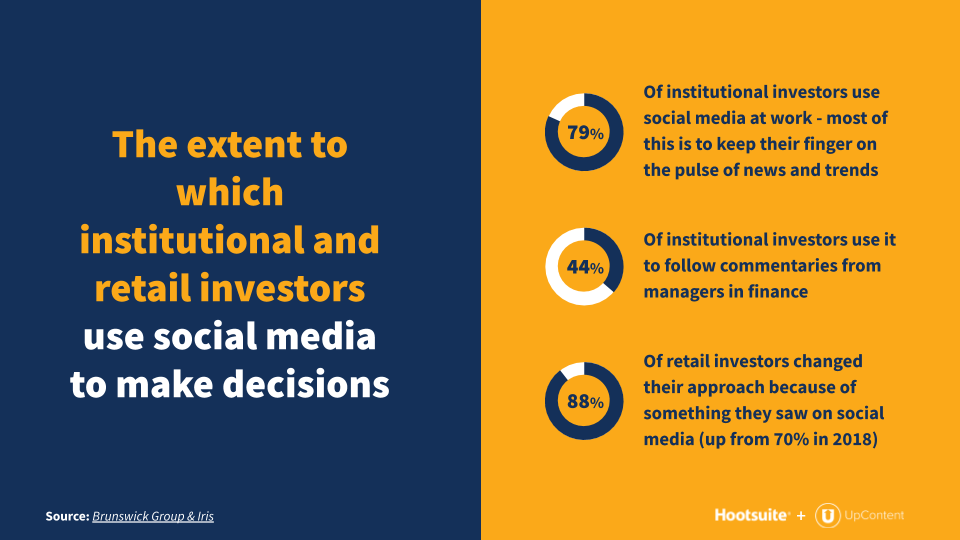How Financial Services can Scale their Business using Social Selling
Brands with strong and professional social media presence achieve 81 percent engagement with buyers. On the other hand, up to 76 percent of social media buyers are ready to engage in sales conversations.
At least half the global population is on social media today. This concept of marketing has therefore never been this relevant.
Insights indicate salesforce using social media platforms are closing 51 percent more sales than their peers.
Additionally, a sales force using social selling will achieve 18 percent and 21 percent greater pipeline volume and pipeline velocity than those that don't.
Therefore, sales teams that'd rather be in the foreground are smartly utilizing social selling to boost their conversion.
For example, research conducted by the University of Massachusetts, across Fortune 500 financial services found out nearly all these firms had an active online presence. 92 percent of whom claim social media was helping them find new prospects.
This guide is for financial services who'd want to scale their customer base using social selling. Fresh marketing frontiers in the wake of digital media have compelled financial organizations to effectively use networks, or else they risk losing revenue streams to competitors.
A survey conducted by Hubspot across 3,400 marketers from around the globe indicated 28% of businesses prioritized social selling.
According to LinkedIn Sales Solution writer Ethan Andrianos, social selling generates half the revenue of more than 14 leading industries.
Financial services are among the 14. Despite how different businesses conduct different sales practices, social selling was found to even the score between the big and small companies.
This guide is for financial services to take advantage of social selling and increase asset management prospects by approximately 10 percent in one year. A survey by Putnam indicated an average asset gain of $1.4 million in one year for financial services using social media.
Do you see the numbers?
What is Social Selling
Social selling involves using social media to research, find, connect and engage with prospective customers. The most popular platforms include Twitter and Linkedin.
But if you still have an Instagram account or Facebook business profile, you have already engaged in the business of social selling.
Simply, you are going to create a meaningful relationship between your brand and your prospect.
The costs for generating social media leads is 75% in comparison to other platforms. Therefore, you are not going to worry about costs. Social selling will help boost the brand's credibility and engage your community to either view, like, comment, share or subscribe.
Majority of salespersons admit social selling as the root of their success. They added that potential customers they had forged mutual relationships with, had the brand in mind once they were ready to buy.
Certainly, social selling is a process. Besides establishing contact, a process that involves building relationships and identifying audiences with a problem you can solve.
It's about positioning your brand as the sole solution to your prospects problems.
And finally, addressing that problem to eventually convert your prospect to take action.
Disclaimer: Social Selling is not spamming of tweets and private messages to anyone. Social media is used in the wrong way could chase away prospects. And it's not for a modern salesperson to look pushy.
You've learned what social selling is, but then what's important for your business?
Why Social Selling is Important for Financial Services?
In social media marketing, people discover brands through timeline posts and comments. Today, organic reach is facing rates of decline.
Hence, brands are looking for better ways to have their employees hitting the ground and engaging their audience. Effective end-to-end customer experience begins by generating leads through social platforms and followed up with direct messages.
Alongside acquiring new prospects, there are many social selling benefits for financial services. I'm not talking about building a deeper brand -buyer relationship here.
Financial services ought to shift their focus towards retail investors. According to Forbes, millennials are going to own 5X the wealth they own today. Approximately, they will also inherit more than $68 trillion by the year 2030 from their baby boomer parents.
If this is the group that will take position within the retail investment, the majority of them will, unfortunately, be misinformed.
As a result, financial agencies will have to position themselves as credible experts and make their investment management services accessible. This accessibility has to be where most millennials are to be found, and that's social media.
A strong social media presence with a thriving audience will enable financial services to establish safe and steady returns.
A Hootsuite survey found out the average American trusts people they know more than general populations/brands. 70 percent of the people that took the survey voted for people they know. Another survey across retail investors indicated 48 percent trusted their financial advisors because of the technology they use.
Let's take a look at insights from Brunswick Group & Iris.
The extent of social media use and decision-making among institutional and retail investors.

- Institutional investors using social media at work comprise 79 percent. They mostly use social media to keep track of news and industry trends.
- Institutional investors using social media to follow commentaries from financial managers made up 44 percent of the population.
- Retail investors who shifted their business approach as a result of something they saw on social media was 88 percent of the population. This was up from 70 percent back in 2018.
Best Social Selling Practices for Financial Services
According to April Rudin,
"Prospecting today is the art of building relationships other than selling"
On social media, creating the right content is key to building these relationships. Often, this is the most challenging part. A content study conducted on the financial services industry indicated advisors should blend their social media content the right way.
For example, lifestyle content should take 33 percent, Industry content 41 percent and corporate content 26 percent. The ability to engage your audience will heavily rely on having the right content. Ideally, a balanced approach will generate more leads, drive engagement and deliver high conversion.
-1.png)
The role of social media is to build an audience you will engage with. With an established audience, sale teams have a 51 percent likelihood of hitting their quota than teams that don't. Here are ways to create a social selling strategy that lasts.
Establish a digital relationship management system that uses social media, email and your website to drive engagement. Features of a successful social selling program include:
- Service - personal branding - This is humanizing your brand and giving it a persona.
- Natural and Authentic - People want authenticity. This is the key driver for trust and prospects will only take action after trusting the brand.
- Reduce attribution concerns - Don't put much effort into unravelling what channels and accounts are driving more leads and sales. Tracking social media KPIs is crucial but that doesn't mean it should be top of your concerns.
- Measuring - However, remember to measure what you manage. This will offer insight on how to increase performance.
Usually, social selling is a funnel for skyrocketing performance through lead generation and increasing employee engagement. A successful social selling program will have the following rewards:
- Doubling click through rates.
- Sales reps have a 51 percent chance of hitting their quota.
- Employee engagement increases by 20 percent.
- Less customer churn of 33 percent among generated leads.
Scaling Your Social Selling Program
Your social selling program needs a team of employees dedicated to driving social engagement. This team will come in handy while building proper relationships. Responsibilities they take will be:
1. Identifying the right users - These users should be approved by the communication, business and marketing line.
2. Each team player role should be determined through the following criteria:
- Seniority
- Social appetite
- Media training
3. Crafting credible user profiles.
4. Conducting training sessions and onboarding through Hootsuite, Proofpoint or Amplify.
5. Creation and management of personal social media content that entails multi-media content curation.
6. Obtaining approval.
7. Monitoring KPIs and keeping a tab on metrics
8. Troubleshoot Proofpoint and Hootsuite support requests.
9. Promoting content to users.
10. Collecting feedback, testimonials and recommendations from spokespeople.
11. Managing Hootsuite and Proofpoint users list.
12. Conducting workshops and engagement summits.
A social selling program that works needs a solid technology infrastructure. This infrastructure should comprise the following:
- The networks: Access to the social media platforms where your audience spends their time and is receptive to your messaging (e.g. LinkedIn)
- The social media management technology: A social media management technology to help support your team in easily identifying, personalizing, and distributing engaging content that will prompt discussion and help build relationships (e.g. Hootsuite)
- The compliance solution: A technology that supports the automated filtering of content against your compliance criteria and/or provides for a manual compliance workflow. Many of these tools also provide a service to ensure your team meets archiving/discovery requirements (e.g. Proofpoint).
- The content solution: A solution to assist the program administrators in the sourcing, review, and distribution (e.g. UpContent).
- The analytics technology: A way to understand campaign performance at all levels of the "funnel". Clicks, engagements, and comments are great, but it is important to have a way to understand how is this traffic translating into new relationships and opportunities for your team and, ultimately, new business. This is likely a combination of your current website analytics technology (e.g. Google Analytics) and that of your social media management technology (e.g. Hootsuite Analytics).
Conclusion
Social selling is all about building credible relationships between your brand and its prospects, identifying leads, and converting them into buyers.
When you establish the right rapport, the leads will not only take action but return for your solutions in the future. Use social selling to exploit professional tools that will skyrocket your sales.
These tools are important for finding leads, expanding an existing network, strengthening relationships and identifying pain points facing your customers. Twenty-one percent of sales forces who don't use social selling do not understand how to implement it.
Want more?
Since you've already acquainted yourself with what this guide contains, it's time to take your social selling strategy to the next level.
This post was inspired by a joint webinar conducted by Hootsuite's Business Value consultant, Davis Riar and UpConent's Scott Rogerson. You can register for the replay here.
Image Credit:
"Social Media Week Milano :: Il Festival della rete" by br1dotcom is licensed under CC BY 2.0



